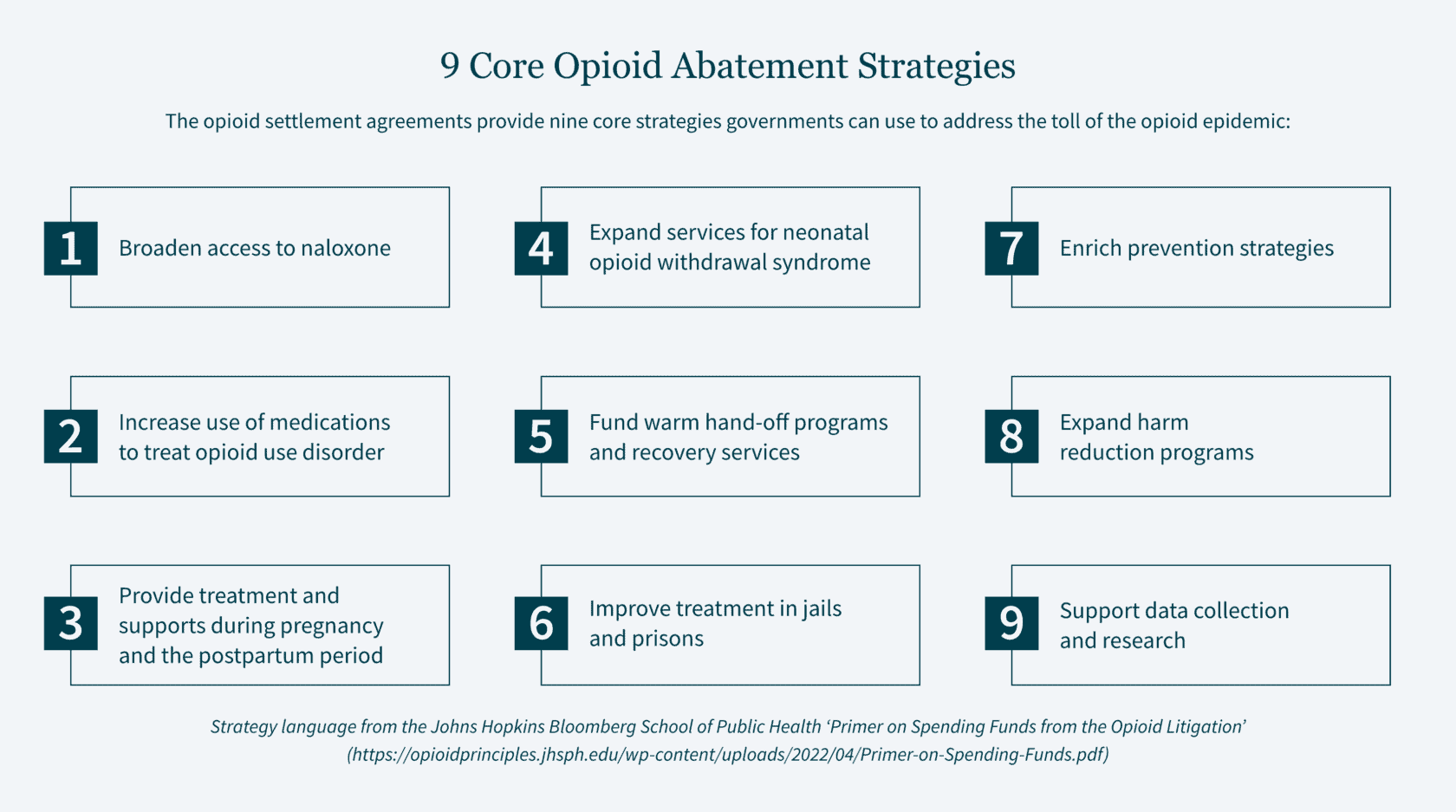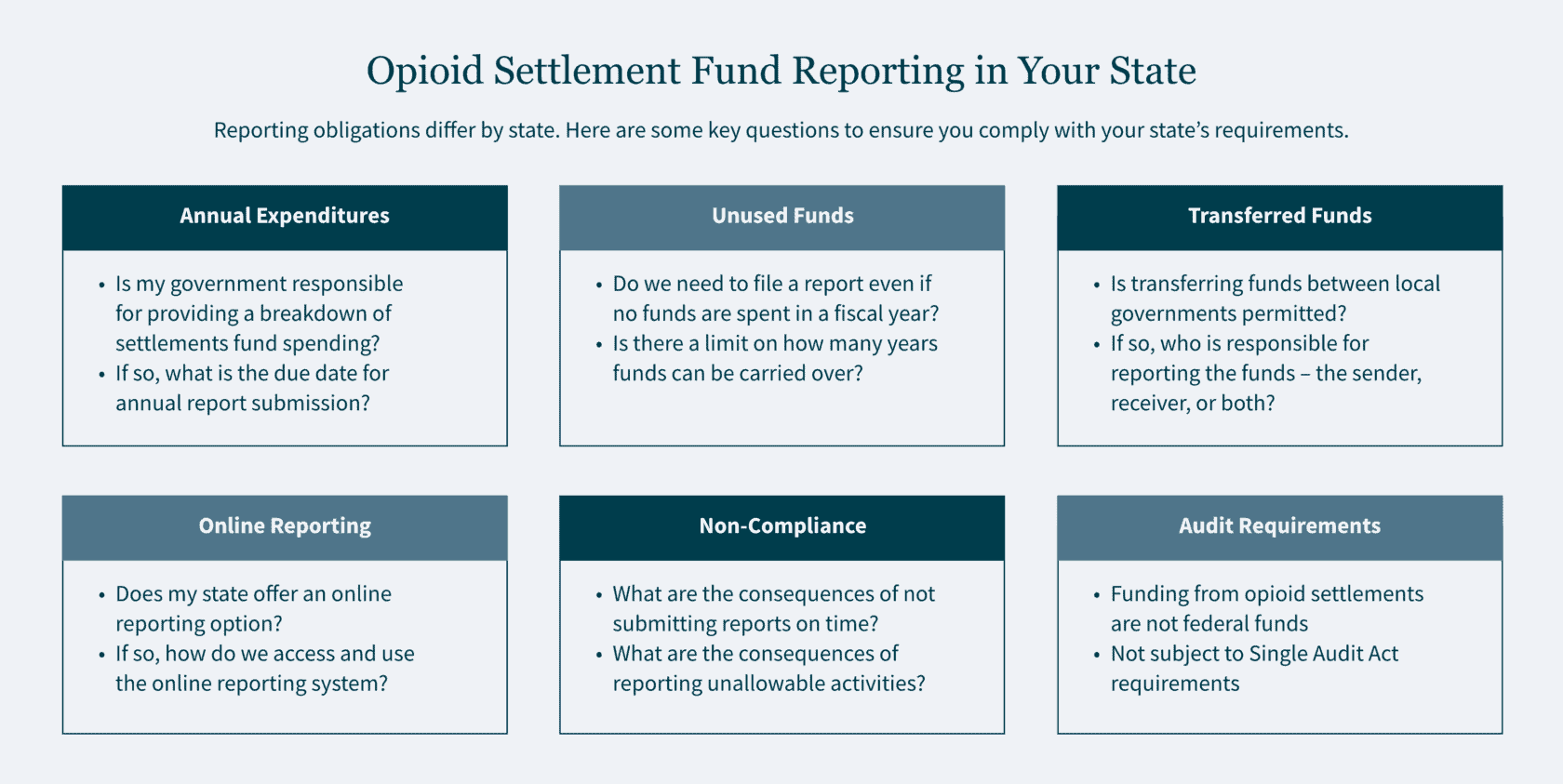Opioid Settlement Fund Reporting – What Your Government Needs to Know

Executive Summary
- States and local governments are receiving billions in funding from opioid settlements over the next two decades to fight the opioid epidemic through approved abatement strategies.
- To avoid misuse, settlements mandate 85% of funds must go toward addressing the opioid crisis, and governments must report annually on expenditures.
- Understanding state reporting rules, deadlines, and processes is critical for local governments to comply with settlement agreements.
~
States and local governments are starting to receive the first round of funding from recent settlements with opioid manufacturers, distributors, and retailers. These funds present an important opportunity to make progress against the ongoing opioid crisis through expanded treatment and prevention efforts.
To ensure states and local governments seize the opportunity to combat the opioid epidemic, settlement creators established acceptable uses for how the money can be spent. These requirements were put in place to avoid a repeat of the tobacco settlement of the 1990s, where states reportedly only spent a small portion of funding on tobacco prevention and cessation programs.
The National Opioids Settlement includes specific language to prevent similar misuse, mandating that "at least 85% of the funds going directly to participating states and subdivisions must be used for abatement of the opioid epidemic." Most states also require local governments to report annual settlement fund expenditures.
As your agency begins to receive, access, and report on funding from opioid settlements, here is an overview of allowable uses, as well as a detailed look at potential reporting requirements.
Spreading Billions of Dollars Across States and Subdivisions to Battle the Opioid Epidemic
The opioid crisis has grown exponentially throughout the 2000s, ravaging communities and depleting resources. In response to this, more than 3,000 states and local governments filed lawsuits against opioid makers and distributors to recover tax dollars spent addressing the epidemic. The suits allege that these companies marketed opioids in misleading ways — downplaying risks, exaggerating benefits, and engaging in reckless distribution practices.
As a result of these lawsuits, several opioid manufacturers, distributors, and retailers agreed to pay settlements totaling more than $50 billion to states, counties, and municipalities. The payouts for these settlements will be made incrementally over periods ranging from 6-18 years. Each state's share of the total settlements is calculated based on factors such as overall population, opioid shipment volumes, opioid use disorder rates, and overdose deaths. Distribution metrics vary from state to state as determined by state legislatures.
Allowable Uses of Opioid Settlement Funds
The settlements require that funds are to be used for "opioid remediation" activities. To paint a clearer picture of what constitutes a remediation activity, the National Settlement Agreements provide Exhibit E, which outlines allowed uses. Exhibit E has two sections: Schedule A lists high-priority, evidence-based Core Strategies; and Schedule B lists an additional set of broader Approved Uses.
Here are examples of allowable uses for opioid settlement funds from both Schedule A and Schedule B:
Schedule A (Core Strategies)
- Expand access to naloxone and medications for opioid use disorder (MOUD)
- Support treatment programs, particularly for pregnant/postpartum women and incarcerated populations
- Fund recovery services and connections ("warm hand-off" programs)
- Broaden evidence-based addiction prevention efforts
Schedule B (Approved Uses)
- Treat opioid use disorder (OUD)
- Connect people who need help to the help they need
- Prevent overdose deaths and other harms
- Educate law enforcement or other first responders

State Limitations on How Funds Are Used
Many states add further limitations on how these funds can be used. For example, California created its own High Impact Abatement Activities (HIAAs) list, and the state requires participating subdivisions to spend no less than 50% of their funds on HIAAs.
HIAA strategies (applicable to California only) include:
- Creating new or expanding substance use disorder (SUD) treatment infrastructure
- Addressing the needs of communities of color and vulnerable populations
- Diversion of people with SUD from the justice system into treatment
- Interventions to prevent drug addiction in vulnerable youth
- Purchase of naloxone for distribution and efforts to expand access to naloxone
Prohibited Uses of Opioid Settlement Funds
The idea is to ensure settlement fund expenditures are connected to addressing opioid misuse, treating opioid disorders, and mitigating the epidemic's effects.
For example, the State of California Department of Health Care Services (DHCS) prohibits spending settlement funds on the following:
- Salaries for staff not involved in abatement activities
- General government administrative costs more than 10% of the total allocation
- Law enforcement not related to treatment
- Unapproved medications or treatments
- Infrastructure unrelated to prevention, treatment, or recovery
- Any costs not tied to approved abatement strategies
Understanding Your State’s Opioid Fund Reporting Requirements
Local governments receiving settlement funds must prioritize effective reporting as they move forward. The specific reporting criteria you need to meet will depend on your state. Texas subdivisions currently have no reporting obligations, whereas California subdivisions will need to report expenditures annually.
What and how you report about your fund expenditures will also vary by state. For example, here are six aspects of settlement fund reporting specific to California that may or may not apply to your state (but nonetheless should be on your radar):
- Annual Expenditures – Most local governments will file annual reports. These reports typically break down dollars spent on approved abatement strategies over the past year. States may also ask for planned expenditures for the coming year as well. Make sure you add your report submission due dates to the calendar. These dates will vary from state to state, but are expected to be the same each year moving forward.
- Unused Funds – In California, local governments must still complete annual reporting even if no settlement funds were spent or committed during a given fiscal year. The reports should show any dollars being carried over or reserved for future abatement activities. Unused funds can be retained year to year, but must be fully expended within five to seven years (depending on the type of expenditure).
- Transferred Funds – In California, if settlement funds are transferred from one participating government to another, both must report the transaction. The sender reports the transfer amount while the recipient reports the funds as money received from another subdivision.
- Online Reporting – Many states, like California, are creating online reporting systems to track opioid settlement expenditures. Governments will need to familiarize themselves with these reporting tools as they come online.
- Non-Compliance – Meeting your reporting obligations is essential to maintaining access to this funding. Failure to submit timely reports or spending on unallowable activities may result in an audit of fund usage or legal action. Accurate reporting also demonstrates good stewardship to the mission of the National Opioids Settlement.
- Audit Requirements – The Single Audit Act requires an annual audit of non-federal entities that spend $750,000 or more of federal funds in a fiscal year. Opioid settlement funds are not federal funds and therefore not subject to Single Audit Act requirements.

Maximizing the Impact of Your Government’s Opioid Settlement Funds
The opioid epidemic's staggering cost defies calculation, with an estimated $1.5 trillion in damages in 2020 alone. Beyond the numbers lie lives lost, families shattered, and communities ravaged. While the National Opioids Settlement can never truly compensate for this immeasurable loss, it does offer states and local governments a chance to reshape the future.
With billions in abatement funding flowing to local communities over the next two decades, ensuring compliance with opioid settlement guidelines will enable you to maximize the impact of every dollar while avoiding the risks of non-compliance. Our experienced state and local government advisors can assist you in tracking allowable spending and meeting reporting requirements so that you can get the most out of these vital funds. Contact our practice today to learn more about how we can help your government achieve its goals.